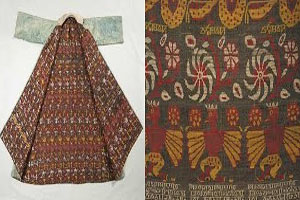
UK museum to display apparel from 17th century Assam
YarnsandFibers News Bureau 2017-04-12 11:00:00 – GuwahatiA Vrindavani Vastra exhibition will be held at Chepstow Museum, United Kingdom in partnership with the British Museum organized by Anne Rainsbury, Curator of Chepstow Museum, where a piece of apparel from 17th century Assam will be featured is this exhibition. The piece on display appears to be part of a gown meant for men known as 'banyan'. With intricate details, the banyan is woven from exquisite Assam silk found only within the state.
Only about 20 pieces of this type of textile (Vrindavani Vastra) exists today, in collections around the world. It is known for the dramatic representation of Krishna's life which are woven on the Vastra. Chepstow Museum has invited Rini Kakati, FASS, and an NRI Assam Co-ordinator for the UK as a guest to celebrate ‘Hidden in the Lining – Krishna in the garden of Assamâ€.
In 2016, the banyan from the Monmouthshire Museum Collection featured in the exhibition at the British Museum titled 'Krishna in the Garden of Assam: the cultural context of an Indian textile'. That exhibition focussed on the largest surviving example of the Vrindavani Vastra-type of textiles, now in the
British Museum, said Rini Kakati, UK coordinator of Friends of Assam and Seven Sisters.
According to experts, the British Museum's Vrindavini Vastra piece and the lining of the banyan belong to the same period. They both have the same brown background colour, the strips of cloth are of similar width, and the same scenes are depicted on both.
At over 9 metres in length, it is made up of 12 separate lengths of cloth woven in Assam, which were stitched together later, probably in Tibet, with strips of damask and brocade along the top.
The textiles probably date from around 1680 and are associated with the worship of Krishna. They are decorated with the same scenes from Krishna’s life that also feature in plays and dance dramas performed to music and with elaborate masks that are distinctive to the region.
The exhibition also includes some spectacular masks made in a monastery in Assam where the dramas are enacted at a festival in late October. The monastery is one of a number on the island of Majuli in the Brahmaputra river. Some spectacular films made on the island during the festival will also be part of the exhibition, the release added.
The British Museum Vrindavani Vastra textile travelled from Assam to a Buddhist monastery in Tibet, while the textile that was cut to make the lining of the banyan that stars in the exhibition, travelled a different route to the West.
Combined with a subtle Chinese blue green damask silk, the dressing gown was probably made in Calcutta for a European man who had made his fortune in India to wear in the West. New light has been shed on the possible identity of the owner, and how it came to be amongst a collection of 18th century costume in Monmouthshire.
This exhibition at Chepstow Museum explores the origins of these two amazing textiles and their intriguing history.
The exhibition opens from Thursday April 13 to September3, 2017 at Chepstow Museum, Bridge Street, Chepstow, Monmouthshire. The exhibition is coinciding not just with the start of Easter, but with the Assamese New Year Festival of Rongali Bihu.
Market Intelligence
Ask for free sample Report

experience
Customer Base
dedicated team
Countries Served Worldwide









